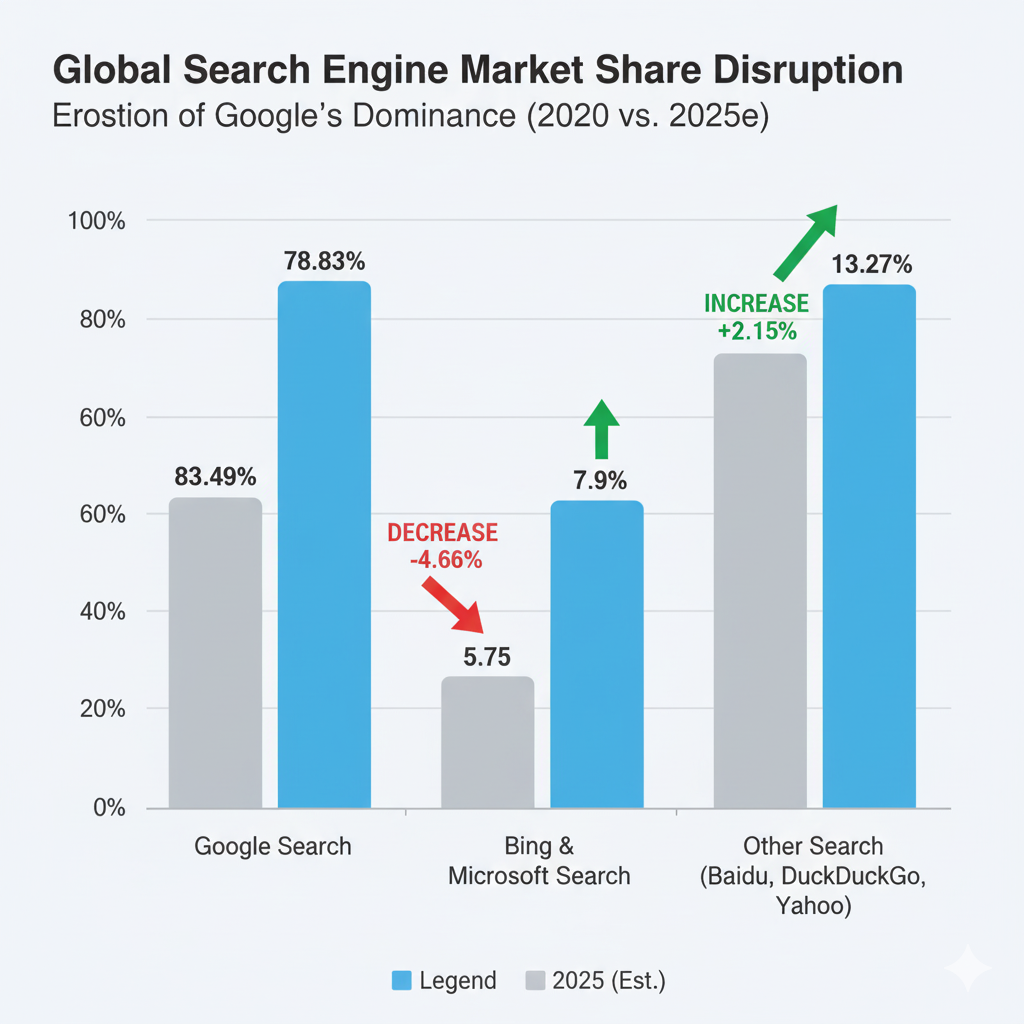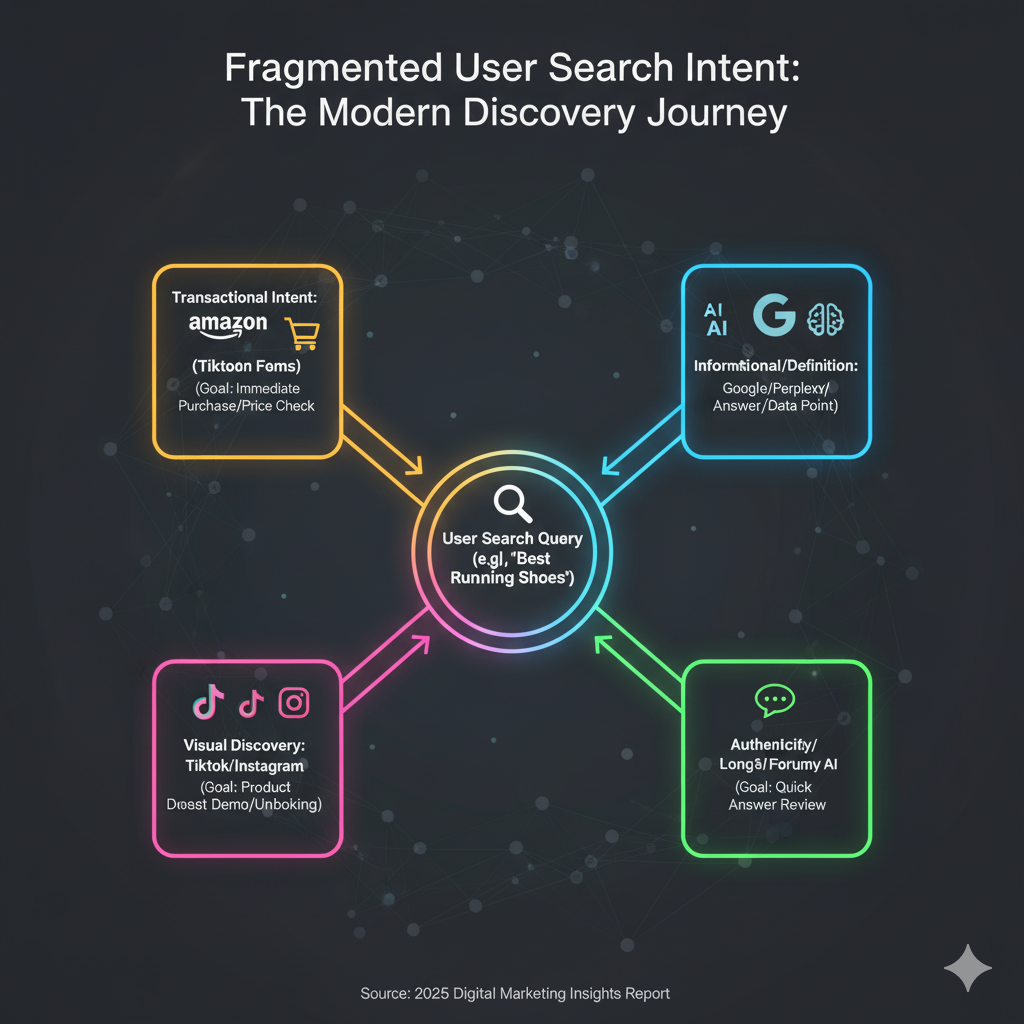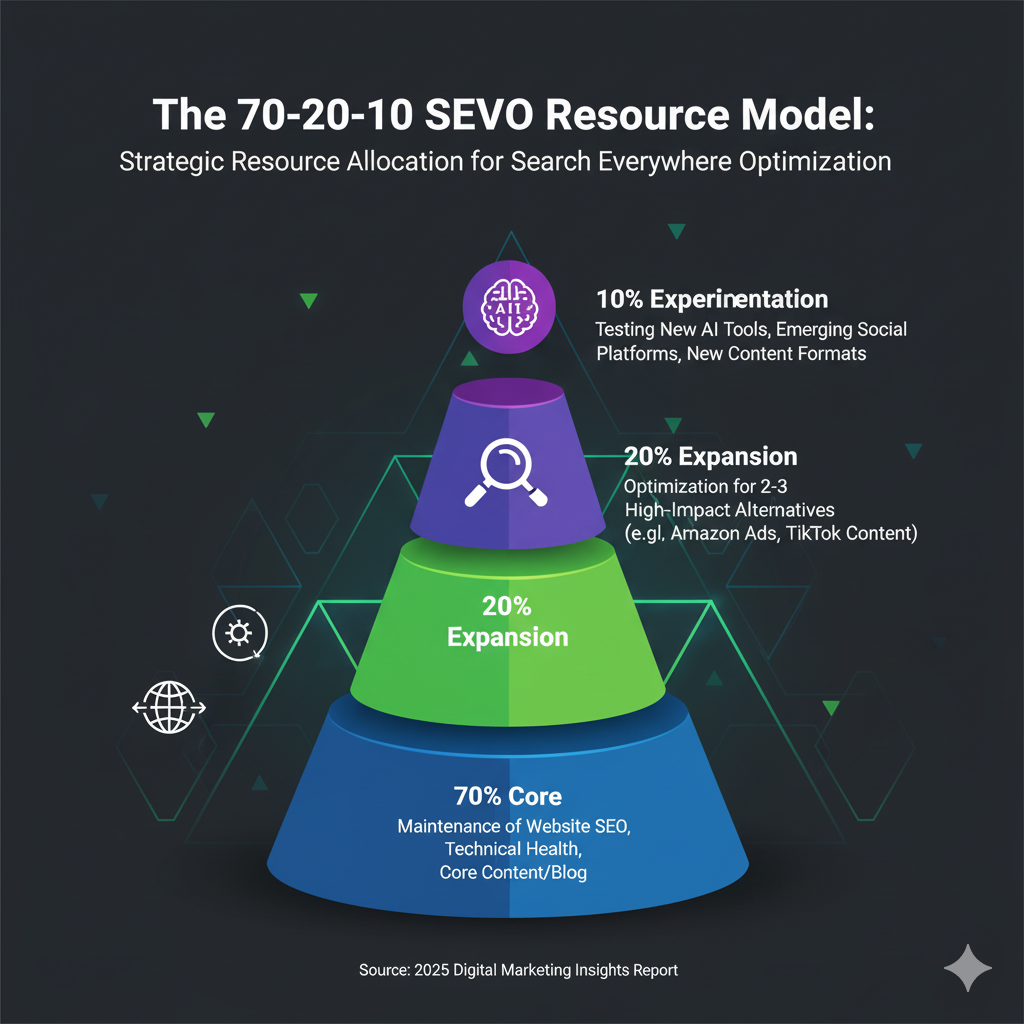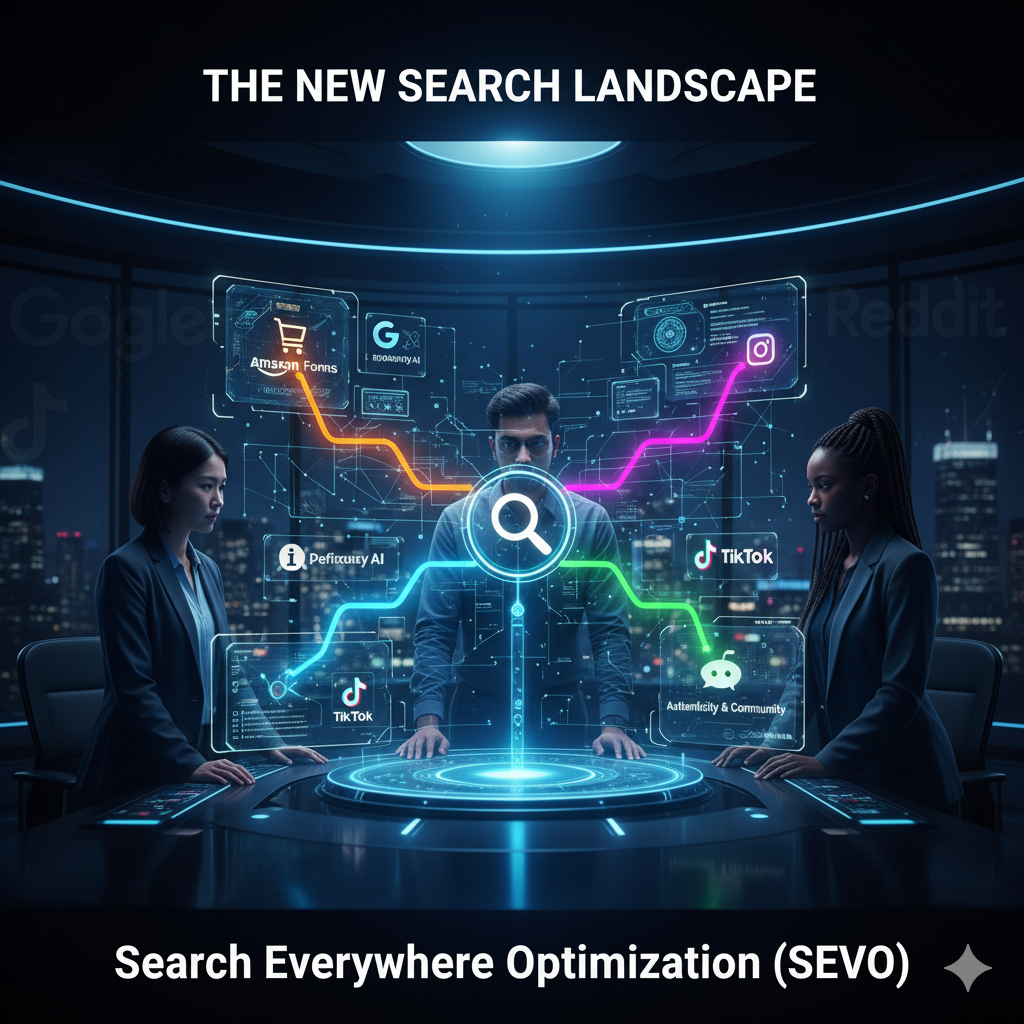Google Search Faces Ongoing Disruptions — Here’s What Marketers Should Know
I. Introduction: The Evolving Landscape of Online Discovery
For nearly two decades, Google Search served as the undisputed primary gateway to the internet. Whether a consumer needed to research a service, purchase a product, or find specific information, the action began with a query in the Google search bar. This historical dominance instilled a single-platform mindset in digital marketing, making Search Engine Optimization (SEO) synonymous with optimizing for Google’s algorithms.
However, the digital landscape is undergoing a fundamental transformation. Consumers are rapidly shifting their search behavior, increasingly turning to a diverse array of platforms, including social media feeds (like TikTok and Instagram), dedicated eCommerce marketplaces (like Amazon), and emerging AI-driven tools (like ChatGPT and Perplexity AI). This behavioral shift marks the end of Google’s sole reign. The new reality for brands is that relying exclusively on Google for visibility is now insufficient and financially risky; diversification of search strategy is the key to capturing current, fragmented search traffic.
II. The Rise and Plateau of Google Search
Google’s initial dominance was revolutionary. By prioritizing relevance, authority, and user experience, its algorithm eliminated the overwhelming clutter of earlier search engines like Yahoo and AltaVista, establishing a new standard for online discovery. For years, the foundation of every major digital marketing strategy rested upon mastering Google’s rules, making SEO and Google Ads the cornerstone of driving online traffic and conversions.
Today, while Google remains the single most influential search engine, it has reached a plateau. It is no longer guaranteed to be the first or only place a user begins their journey of information retrieval or product research. This shift signals a mature market, where alternative behaviors and technologies are successfully challenging the single, established method of search.
III. Google’s Market Share Is Shrinking
The most quantifiable evidence of this ongoing disruption is the steady decline in Google’s market share. While traditionally holding a near-monopoly above 85%, recent data from early 2025 indicates a measurable dip. Google’s share has fallen (e.g., from an estimated 83.49% to 78.83%), while competitors, particularly Bing, are experiencing significant growth, often attributed directly to the integration of advanced AI technology. Furthermore, other players like DuckDuckGo are seeing gradual growth as user concerns over privacy increase.

[INFOGRAPHIC: Global Search Engine Market Share Disruption]
- Type: Dual-axis line or bar chart comparing 2020 data vs. 2025 (Estimated) data.
- Y-Axis: Market Share Percentage (0% to 100%).
- Data Points:
- Google: 83.49% (2020) vs. 78.83% (2025)
- Bing/Microsoft Search: 5.75% (2020) vs. 7.9% (2025)
- Other Search (Baidu, DuckDuckGo, Yahoo): 10.76% (2020) vs. 13.27% (2025)
- Visual Focus: A clear downward arrow pointing from Google’s 2020 bar to its 2025 bar, contrasting with upward arrows for competitors. [/INFOGRAPHIC]
The implication for businesses is straightforward: brands that only optimize their presence for Google are actively ignoring a growing, significant percentage of available search traffic. The audience is migrating, and a static, Google-centric SEO strategy is missing out on these high-intent searches.
IV. Why Google’s Search Model Is Struggling (The Disruptions)
The decline in Google’s search dominance is not due to a single failure, but rather a perfect storm of internal strategic decisions and external technological innovations that have diminished the user experience and scattered user attention.
A. The Prioritization of Paid Over Organic
The most immediate cause of user dissatisfaction is the aggressive commercialization of the Search Engine Results Page (SERP). As Google is fundamentally an advertising company, its business model necessitates prioritizing paid placements. Today, the screen is increasingly dominated by sponsored content, shopping carousels, and highly visible ads. Data suggests that organic results are continually pushed further down the page, often appearing below the ‘fold’—the visible screen area—especially on mobile devices. This aggressive monetization compromises the core value proposition of a search engine: providing the best, most relevant answer quickly.
B. Decline in User Experience and Content Quality
The user experience (UX) of Google Search has noticeably degraded, leading to widespread user frustration. The SERP is now cluttered with a multitude of “Search Features” (Featured Snippets, People Also Ask boxes, knowledge panels) and low-quality content. The internet is now awash with SEO-optimized, yet thin or AI-generated articles, making it harder for high-quality, authoritative sources to surface. When users are forced to click through multiple pages of irrelevant or redundant links—a phenomenon often called “pogo sticking”—they lose trust in the platform and seek alternatives that offer immediate clarity and less noise.
C. The Rise of Instant, Conversational AI
A massive external disruption comes from AI-driven search competitors. Platforms like ChatGPT, Perplexity AI, and the AI integrated into Microsoft’s Bing offer a fundamentally different search interaction. Instead of the user typing a query, clicking a link, and reading a webpage, these tools provide an instant, curated, and conversational response tailored to the user’s specific question. This shifts the value from finding a link to getting an answer. As users increasingly favor this intuitive, time-saving method, the traditional ten blue links model of Google feels increasingly outdated.
D. The Social and Shopping Search Migration
Crucially, user behavior has fragmented the search journey entirely. Younger demographics, in particular, are bypassing Google entirely for specific needs:
- Product Research: Users go directly to dedicated e-commerce marketplaces like Amazon, which offers immediate purchase intent and product reviews.
- Discovery and Trends: Users turn to visually rich platforms like TikTok and Instagram for food recommendations, travel ideas, and product unboxings. For Gen Z, scrolling through a video feed feels more natural for discovery than typing into a traditional text box.
- Authentic Discussions: Users seeking non-commercial, authentic opinions and troubleshooting often start their search on community-driven sites like Reddit.

[INFOGRAPHIC: Fragmented User Search Intent Diagram]
- Type: Flowchart or Hub-and-Spoke Diagram.
- Center Node: User Search Query (e.g., “Best Running Shoes”).
- Outgoing Spokes (Intent & Platform):
- Transactional Intent: Path leads to Amazon (Goal: Immediate Purchase/Price Check).
- Visual Discovery Intent: Path leads to TikTok/Instagram (Goal: Product Demo/Unboxing/Vibe Check).
- Authenticity/Long-Tail Intent: Path leads to Reddit/Forums (Goal: Honest User Review/Troubleshooting).
- Informational/Definition Intent: Path leads to Google/Perplexity AI (Goal: Quick Answer/Data Point).
- Visual Focus: Show Google as one of four equal paths, emphasizing that the starting point is determined by user need, not platform habit. [/INFOGRAPHIC]
This fragmentation means that a significant portion of high-intent search traffic is simply occurring off of Google’s domain, requiring marketers to diversify their visibility strategies far beyond traditional SEO.
V. The New Playbook for Marketers: Adapting to Fragmented Search
The path forward for digital marketers demands a complete re-evaluation of where and how they seek visibility. The new mandate is to embrace Search Everywhere Optimization (SEVO), recognizing that search is now a multi-platform, multi-format endeavor. Adaptation requires a three-pronged approach: strategic diversification, AI-native content creation, and an overhaul of success metrics.
A. Implementing Strategic Diversification
Brands can no longer afford a monolithic, Google-centric strategy. A balanced resource allocation is necessary, often framed by the 70-20-10 model: dedicating 70% of resources to maintaining a strong SEO foundation on core web properties, 20% to systematically expanding presence on 2-3 high-impact alternative platforms, and 10% for experimenting with emerging technologies. This approach minimizes risk while ensuring continuous exposure. Furthermore, effective diversification requires a unified brand voice across all channels—from website FAQs to TikTok videos—to reinforce authority and consistency wherever the customer finds information.

[INFOGRAPHIC: The 70-20-10 SEVO Resource Model]
- Type: Stacked Bar Chart or Pie Chart.
- Title: Strategic Resource Allocation for Search Everywhere Optimization (SEVO).
- Sections:
- 70% Core: (Color A – Large section) Description: Maintenance of Website SEO, Technical Health, Core Content/Blog.
- 20% Expansion: (Color B – Medium section) Description: Optimization for 2-3 High-Impact Alternatives (e.g., Amazon Ads, TikTok Content).
- 10% Experimentation: (Color C – Small section) Description: Testing New AI Tools, Emerging Social Platforms, New Content Formats.
- Visual Focus: Use distinct icons for each section (e.g., a globe for Core, a magnifying glass for Expansion, a brain/AI symbol for Experimentation). [/INFOGRAPHIC]
B. Optimizing for Conversational AI (AEO)
The rise of conversational AI (like ChatGPT and Perplexity AI) necessitates Answer Engine Optimization (AEO). Since these LLMs often generate “zero-click” answers by synthesizing information from multiple sources, content must be structured for easy extraction and citation.
- Clarity and Structure: Content should lead with the answer, using descriptive headings and clear Schema.org markup (such as
FAQPageorHowTo). This modular approach allows AI to confidently extract and quote a brand’s definitive answer. - E-E-A-T Proof: To win AI citations, a brand must demonstrate superior Experience, Expertise, Authoritativeness, and Trustworthiness (E-E-A-T). This means prominently featuring author credentials, citing first-hand data, and ensuring the content cluster reinforces the brand’s identity as an expert entity in its field.
C. Creating Platform-Native Experiences
To capture traffic migrating away from Google, marketers must embrace the unique format and user intent of each new search engine:
- Amazon (Transactional Search): Optimization here means improving conversion, not just traffic. Focus entirely on high-quality product photography, concise and keyword-rich titles, detailed feature descriptions, and proactive management of customer reviews and ratings.
- TikTok (Visual Discovery): As a visual search engine, optimization requires keywords in four places: the video title/caption, on-screen text overlays, spoken audio (which the algorithm indexes), and relevant hashtags. Content must be inherently engaging, often following a Hook-Value-Action framework to maximize watch time, which is the primary ranking signal.
- Reddit (Authenticity Search): Visibility on community platforms requires participation, not promotion. Brands must identify relevant subreddits and optimize for long-tail, question-based queries by offering genuine, helpful, non-commercial insights. A best practice is including a TL;DR (Too Long; Didn’t Read) summary at the beginning of detailed posts to quickly provide value and satisfy user intent.
D. Measuring Influence, Not Just Rank
Traditional SEO metrics (like organic rank and impressions) are insufficient in a fragmented search landscape. Marketers must now track metrics that reflect cross-platform influence:
- AI Citations: Monitoring the frequency with which a brand’s website or entity is referenced as a source within AI-generated answers provides a direct measure of AEO success.
- Assisted Conversions: Using advanced multi-touch attribution models to determine how often non-Google touchpoints (like a TikTok video or a Reddit thread) influenced a final purchase.
- Brand Query Lift: Tracking the increase in direct brand searches across all platforms (Google, Amazon, social media) as a result of diversified marketing efforts.
- Social Sentiment and Feedback Loops: Tracking the volume and tone of comments, shares, and mentions on platforms like Reddit, TikTok, and Instagram is essential. Positive social sentiment—manifested as engagement, deep discussion, and community validation—is a powerful signal of content authority and community resonance. Monitoring these feedback loops provides crucial insight into brand perception and directly influences ranking algorithms on those specific social search platforms.
VI. Case Studies in Search Everywhere Optimization
The effectiveness of a multi-platform strategy is best demonstrated through real-world application, showing how brands are earning visibility outside of the traditional Google ecosystem.
Case Study 1: AI-Native Content and Entity Authority
Brand/Industry: TechStack Solutions (B2B SaaS) Challenge: Highly technical, competitive keywords dominated by large publications. Strategy (AEO Focus): TechStack shifted its blog strategy from long-form listicles to hyper-specific, structured “Definitive Guides” around niche concepts (e.g., “Non-Relational Database Sharding”). These guides utilized clear, modular content blocks, H2/H3 tags that posed and immediately answered specific questions, and robust author bios to establish E-E-A-T. Result: While organic traffic from Google SERPs remained stable, TechStack observed a significant increase in AI Citations. When users posed complex, conversational queries to LLMs (like “Explain database sharding to a beginner”), TechStack’s content was frequently cited as the primary, authoritative source, driving highly qualified traffic interested in the underlying software.
Case Study 2: Visual Discovery and Social Search
Brand/Industry: GlowUp Cosmetics (Direct-to-Consumer Beauty) Challenge: Gen Z audience was using TikTok search to find makeup tutorials and product comparisons, bypassing Google and YouTube. Strategy (TikTok SEO): GlowUp adopted a platform-native approach. Instead of linking to blog posts, they produced short, action-oriented videos focusing on product use (e.g., “3 ways to apply contour”). They optimized videos by placing keywords in the title (“Contour Tutorial for Beginners”), using a trending audio track, and adding on-screen text labels for key product names. Result: GlowUp’s “how-to” videos consistently appeared at the top of TikTok’s search results for transactional queries, leading to a 40% increase in direct traffic to their product pages and a measurable lift in branded searches across all platforms, validating their visual discovery strategy.
Case Study 3: Community Trust and Authenticity Search
Brand/Industry: DurableGear (Niche Outdoor Equipment) Challenge: Potential customers were asking detailed, pre-purchase questions about durability and longevity in niche communities. Strategy (Reddit Optimization): The brand identified relevant subreddits (e.g., r/UltralightCamping) and tasked a community manager (who was identified with a genuine flair) to participate non-promotioanlly. They actively monitored long-tail keywords (e.g., “best compact stove for Everest base camp”) and replied with high-value, fact-based answers that included a TL;DR summary. They avoided direct sales links but provided context-rich, helpful threads. Result: Multiple DurableGear community threads began ranking on the first page of Google SERPs for highly specific, high-intent queries (e.g., “DurableGear stove review”). This positioned the brand as an authentic, trustworthy source, driving highly qualified leads who had already vetted the product through community discussions.
VII. Conclusion: The Future of Digital Visibility
The era of Google’s unchallenged dominance as the sole gatekeeper of the internet is over. The fragmentation of user attention across conversational AI, e-commerce marketplaces, and social media platforms represents not a temporary challenge, but a permanent structural shift. For digital marketers, this transition demands that they evolve from being simple SEO specialists to becoming holistic digital strategists.
Success in the fragmented search economy hinges on building content that is definitive, trustworthy, and delivered in the native format of the platform where the user is searching. By embracing Search Everywhere Optimization, prioritizing Answer Engine Optimization, and shifting measurement away from simple ranking toward broader influence and conversion attribution, brands can transform the disruption of Google’s plateau into an opportunity for greater visibility and resilience across the entire digital ecosystem.


